By Megan Gambino via Smithsonian.com

Cerro Prieto Geothermal Power Station, Baja, Mexico 2012. © Edward Burtynsky, courtesy Nicholas Metivier Gallery, Toronto / Howard Greenberg Gallery and Bryce Wolkowitz Gallery, New York.
Throughout his career, photographer Edward Burtynsky has been on a quest to capture the impact humans have on the natural landscape. “Nature transformed through industry” is how he puts it. Burtynsky has photographed e-waste recycling facilities in China, nickel tailings in Ontario, railways cutting through the forests of British Columbia, quarries in Vermont and mines in Australia. He has also turned his lens to suburban sprawl, highways, tire piles, oil fields and refineries.
“I think it’s been a bit of an evolution,” says Burtynsky, about his body of work, “and it is always a challenge to kind of go to that next phase and try and solve a whole new set of problems.”
This fall, the acclaimed Canadian photographer is releasing a powerful trifecta: a new book, a documentary film and multiple exhibitions all on the theme of water.
From 2007 to 2013, Burtynsky journeyed across the United States, Mexico, Iceland, Europe and Asia documenting our dependency on the natural resource. The series of aerial photographs depicts the many ways humans literally reshape the Earth—from waterfront development in Florida to dryland farming in Spain, hydroelectric dams in China and ancient stepwells in India to desert shrimp farms in Mexico—in an effort to harness water for their own needs. In some of the images, most memorably those of Owens Lake and the Colorado River Delta, water is conspicuously absent, showing quite dramatically the consequences of our engineering.
The photographer’s new book, Burtynsky – Water, released by Steidl this month, features more than 100 of the photographs. Similarly, Watermark, a 92-minute documentary Burtynsky co-directed with Jennifer Baichwal, premiering at this month’s Toronto International Film Festival and showing in Canadian theaters this October, is chock full of footage from his travels.
There will be multiple opportunities to see the large-scale photographs on display as well. The Bryce Wolkowitz Gallery and Howard Greenberg Gallery, both in New York, are showing Burtynsky’s work from September 19 to November 2, 2013. Then, “Edward Burtynsky – Water,” a 60-plus piece exhibition organized by the New Orleans Museum of Art will make the first stop of a multi-site tour at the Contemporary Arts Center, New Orleans, from October 5 to January 19, 2014.
I had the opportunity to speak with Burtynsky about his motivations for Water, his thought process in choosing the locations he featured and some of the challenges he faced in the shoots. He also told me why he thinks this series is his most poetic to date.
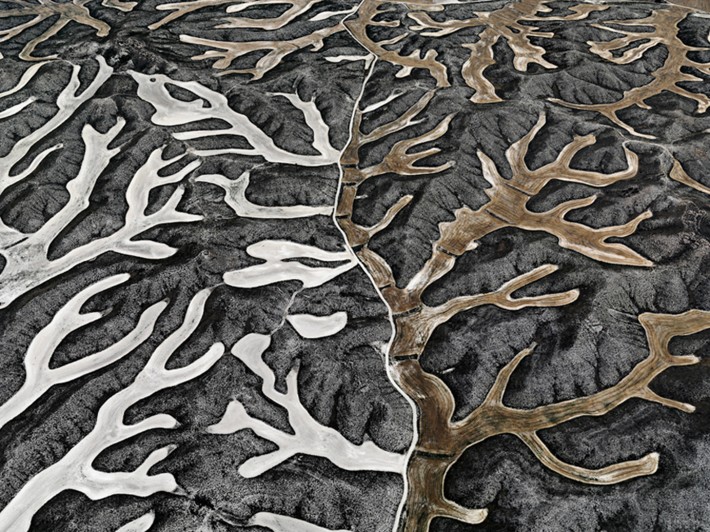
Dryland Farming #2, Monegros County, Aragon, Spain 2010. © Edward Burtynsky, courtesy Nicholas Metivier Gallery, Toronto / Howard Greenberg Gallery and Bryce Wolkowitz Gallery, New York.
You have photographed strip mines, tailing ponds and quarries. What made you turn to water as a subject?
At the Corcoran [Gallery of Art], I got the chance to work with Paul Roth, who is a curator, and we did a big show on oil. I had been working on oil on and off for 12 years. Finishing the oil project, I started to think about where to go next. Water seemed to be even more important than oil in terms of a vital resource. Without oil, it is going to be difficult, but we can do work-arounds. There are at least alternatives. But there really is no alternative to water.
Yes, there are the oceans. We can imagine a way to desalinate it, but industrial desalination, pumping water over great distances and the pipelines involved are very costly. We may have to resort to piping it to keep certain cities alive, but a far more clever idea would be to not expand into deserts very much and to be able to maintain and manage the existing water we have as best as possible to not be wasteful. Water is a finite resource like anything else. It can be over-used, abused and can disappear.
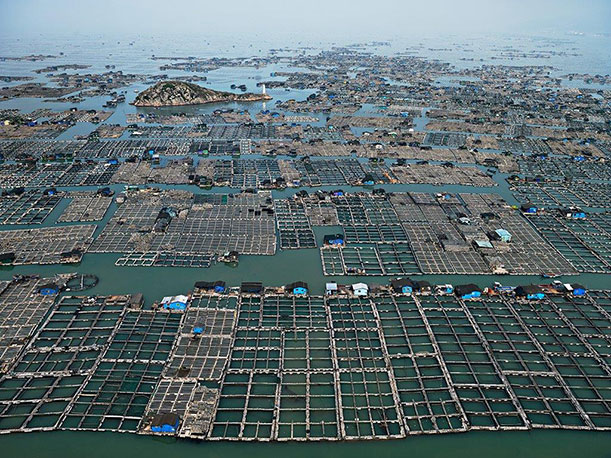
Marine Aquaculture #1, Luoyuan Bay, Fuijan Province, China 2012. © Edward Burtynsky, courtesy Nicholas Metivier Gallery, Toronto / Howard Greenberg Gallery and Bryce Wolkowitz Gallery, New York.
The locations you shot for Water span the globe. How did you decide on them? What criteria did you have?
Visually, it needs to have some substance. All of these images are representing a much larger human activity. The dam that represents all dams. The farm that represents all farms. It is really about representing these different themes of agriculture; aquaculture; the source of water; waterfront as real estate and waterfront as spiritual cleansing, like the Kumbh Mela festival in India; and water as a form of entertainment—beaches in Spain or the surfing derbies in Orange County at Huntington Beach.
Then, it is about looking at water where we’ve got it wrong, where something has happened, like Owens Lake, where the Los Angeles aqueduct was diverted back in 1913. [The diversion led to] the whole drying up of Owens Lake and a toxic lake bed that causes all kinds of dust storms that rain down on other towns in the area. The Salton Sea was another area under distress, because all of the pollutants coming in from the Imperial Valley and the Central Valley going into the Salton Sea were causing all kinds of algal blooms, where all the oxygen has been sucked out of it and all of the fish that swim into it die.
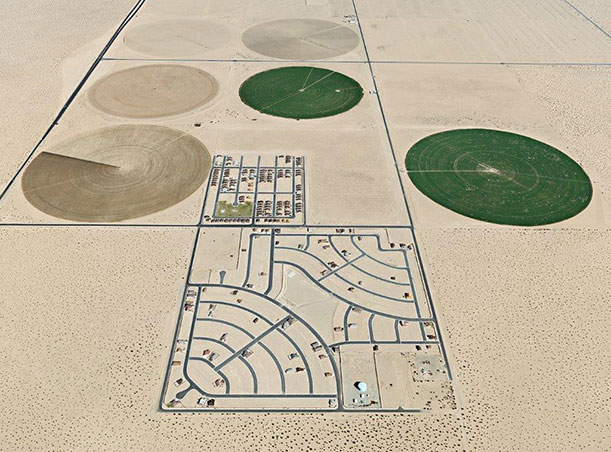
Pivot Irrigation / Suburb, south of Yuma, Arizona, USA 2011. © Edward Burtynsky, courtesy Nicholas Metivier Gallery, Toronto / Howard Greenberg Gallery and Bryce Wolkowitz Gallery, New York.
What was the greatest length you went to in order to perch yourself up in the air for a shot?
Probably the most complicated is putting my Hasselblad [camera] onto a remote helicopter that could carry the load and all of the technology we had to figure out to get a camera in the IP so that I could see what I was framing. To be able to remotely fly a helicopter, see what I am shooting and compose and shoot from about 1,000 feet away looking at a screen—to me, that was a bit nerve-wracking. I think the helicopter was insured for $150,000, and I had a $60,000 get-up on it. We had $210,000 hovering up there, above water [over a marine aquaculture site in China]. Nobody lost anything, but it was a pretty pricey little payload up there doing that work.
You stress the aerial perspective. Why is it important to lose the horizon within the frame?
Sometimes I keep it and sometimes I lose it. Usually, I only keep a thin amount of it. Most of the time I am looking at the ground or human systems on the ground. I am interested in how we change the land and turn land into things that we need, whether it is farmland, a quarry, a strip coal mine or an oil field. We take that area over and we do what we feel necessary to get what we need to get from it. I needed to get up to see the effect.
You can try and photograph a farm from the road, but you’ll see stalks of corn or stalks of a wheat and you don’t get the sense of scale of that operation. You can never get a feeling for how broad and how wide farming reaches. Getting up in a helicopter or getting up on tall lifts became an apparent way to tell the story of water. It calls for a large view and a greater distance—to understand what is actually happening, how water is being directed and what is changing that land, a desert into cropland.
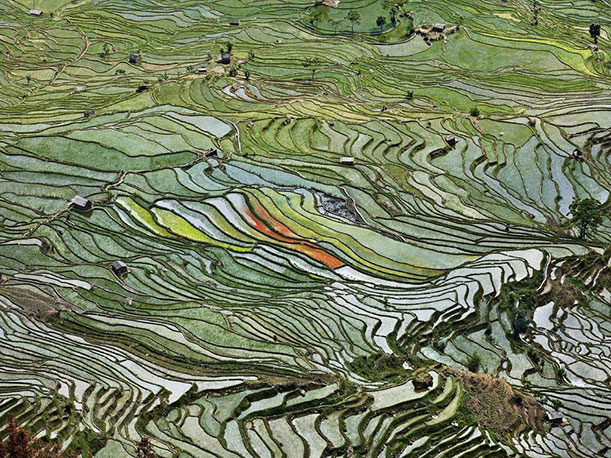
Rice Terraces #2, Western Yunnan Province, China 2012. © Edward Burtynsky, courtesy Nicholas Metivier Gallery, Toronto / Howard Greenberg Gallery and Bryce Wolkowitz Gallery, New York Read.
In the book’s introduction, you say that “this project encompasses some of the most poetic and abstract work of my career.” How so?
In some of the Spanish dryland farming pictures, there is definitely a reference to [artist Jean] Dubuffet, even the colors of Picasso. There are some colors that I remember in Guernica. Even the way the space is broken up and used. [Richard] Diebenkorn had done a lot of what almost looked like aerial perspectives of landscape. I found them interesting works to look at.
There were a lot of moments when I felt the locations and the subject allowed me to kind of approach it with the eye of a painter. I have always kind of treated my film cameras, my 8 by 10 or 4 by 5 and now with a 16 megapixel, as a way to fill the canvas or that frame. What do I fill that frame with? I am constantly putting myself in that crucible. What do I make an image of next? That is always, to me, the great challenge of what I do. The actual making of the image is always quite fun—challenging, but fun. The heavy lifting has been done. I know where I want to go and what it is I want to shoot. Now, I have to nail it. Now, I have to find it. To me, it is deductive reasoning and a bit of detective work to get to the right spot, to maneuver yourself into that place with the right light and at the right time and the right equipment to get the shot that you really wanted.
I was at one point socked in China, when I was doing the rice terraces, for eight days and then left with nothing. It was just fog for eight days. The foreseeable report was the next week all fog. I needed two kilometers of clear air to get the shot that I wanted. The time of the year and the place wasn’t going to give it to me. I had to leave. Then, I went back a year later and got one day when the light was great in a six day shoot. That was it.
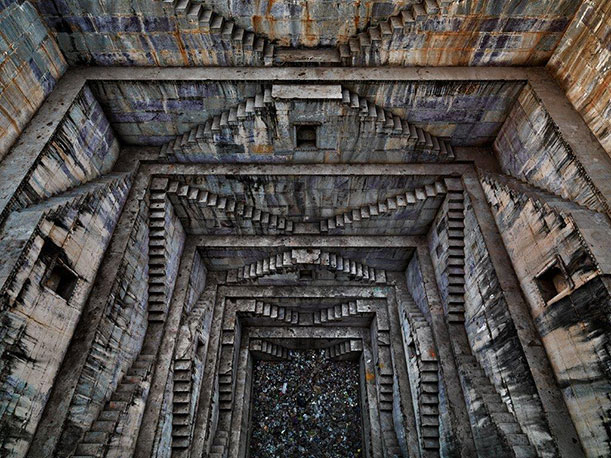
Stepwell #4, Sagar Kund Baori, Bundi, Rajasthan, India 2010. © Edward Burtynsky, courtesy Nicholas Metivier Gallery, Toronto / Howard Greenberg Gallery and Bryce Wolkowitz Gallery, New York.
The series surveys the many ways that humans control water—through marine aquaculture, pivot irrigation and geothermal power stations. What was the most interesting thing you learned?
I never before bothered to ask myself, where does water come from? And, an astrophysicist filled me in that it was from ice asteroids bombarding the Earth. Any ice that still hits our atmosphere gets drawn in by gravity, so water is still coming to the Earth. Small ice chunks and asteroids are still probably hitting our atmosphere and raining down as water.
I asked, why are the oceans salty? That was interesting, because the hydrological cycle and the water that hits the mountains and works down to the watersheds every time dissolves a little bit of salt. That salt stays in solution and ends up in the ocean. The ocean evaporates, and the water still comes back on land. So, the oceans are continually salinating, getting more and more salty over the billions of years.
The minute we humans take water away from a watershed, meaning redivert that water, there is a price being exacted somewhere downstream. It is either the flora and fauna; the life that lives downstream expects that water at a certain temperature and if you dam it, the water comes down warmer, which changes the whole ecosystem downstream. Every time we divert water there is a winner and a loser; the person who got the diversion wins and wherever the water was going and that part of the watershed loses. If you remove that obstruction, it goes right back to what it was very quickly. When you remediate it, it is almost immediate.
It was interesting finding out that 40 percent of the major rivers of the world don’t make it to the ocean. One of them became a very powerful metaphor in the book and the movie, which is the Colorado River Delta in Mexico. The Sea of Cortez hasn’t seen a drop of the Colorado now in over 40 years. I mention that to a lot of Americans and they don’t even know that. The delta used to be verdant with brackish water and all kinds of life in it. The whole delta, the massive, 1,000-square-mile Colorado Delta, is now a bone-dry desert.
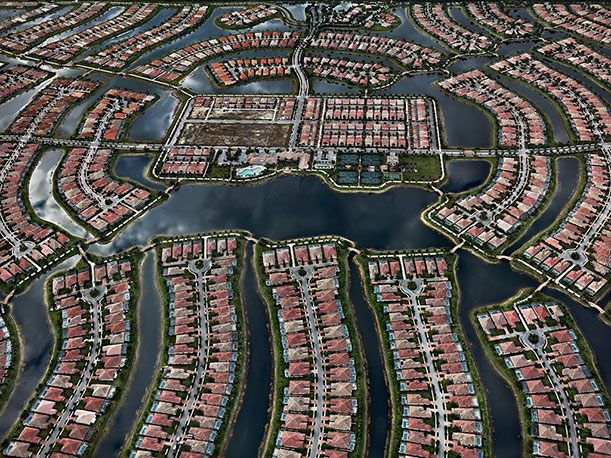
VeronaWalk, Naples, Florida, USA 2012. © Edward Burtynsky, courtesy Nicholas Metivier Gallery, Toronto / Howard Greenberg Gallery and Bryce Wolkowitz Gallery, New York.
What statement do you hope to make with the photographs?
It is not as much about a statement as it is a raising of consciousness. After seeing and delving into this body of work, whoever goes through that will in a way think differently about the role that water plays. Maybe we shouldn’t take it as much for granted as we tend to do as urban citizens who turn on a tap and it’s always there. It’s when that water is coming out of the tap, that there is a slightly elevated and more conscientious view of the importance of that liquid.
With the manufactured landscapes of my previous project in China, what I had hoped was that when someone sees the “Made in China” tag on anything that they are buying, that “Made in China” has a different impression. The series showed a lot of the manufacturing facilities in China and what that looks like. Now there is an image you can associate with “Made in China.”
I am hoping that these are images attached to the idea of water, so that next time you are experiencing it, whether swimming in a lake or a pool or drinking it, maybe the next time you are buying bottled water, you may ask yourself, is this a good idea, or should I just be refilling my water? The monetization of water is to me a very troubling and scary proposition. You have to have money to drink water, I think that’s wrong. I think water is a right to life. If you charge for water, then logically speaking you should be able to charge for air next.

Thjorsá River #1, Iceland 2012. © Edward Burtynsky, courtesy Nicholas Metivier Gallery, Toronto / Howard Greenberg Gallery and Bryce Wolkowitz Gallery, New York.
Do you consider yourself an activist?
I consider myself an advocate for sustainability and a concerned citizen. We [as humans] now clearly have control of the planet, and this is the first time in the history of the planet that the fate of the planet is tied to what we do to it. We have never been there before. It is a question of whether we can act quickly enough and decisively in the right direction to avert the worst of what may be coming. That is a question that just remains to be seen.
An activist, not necessarily. I pull myself back. I prefer to address it more through stills and imagery, now motion picture, and through the writings in my book, to bring awareness and to raise consciousness that this is something that we need to pay attention to. This can come back and get us. For me to move freely through subjects and countries, I would be severely restricted as a card-carrying activist. I am better off as more the poet than the activist. I am going into sensitive places. If those countries or those corporations thought that I was interested in indicting their activities, then why would they let me in? It is pragmatic.
I also believe in the long run it [the imagery] is a very interesting way to bring people to their own conclusions, to understand what the problems are and to own those. I’m not telling them how to think about it. But, if they spend the time to understand what I’m doing, I think logically they will arrive at concern. In that way, if they arrive at it themselves, they will own it in a more powerful way.
“Water” is on display at the Bryce Wolkowitz Gallery and Howard Greenberg Gallery, both in New York, from September 19 to November 2, 2013. The traveling exhibition “Edward Burtynsky – Water” begins its tour at the Contemporary Arts Center, New Orleans, from October 5 to January 19, 2014.
